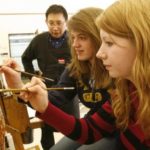
As educators struggle to define effective 21st-century instruction, one practice that many have viewed as fundamental to teaching and learning has come under new fire: catering to different learning styles.
According to a new review of existing research, scientists have yet to show conclusively that students learn better when they are taught according to their preferred modality—and the study’s authors say it’s time to stop funding a technique that hasn’t been proven effective.
Commissioned by Psychological Science in the Public Interest, the main journal of the Association for Psychological Science, the study is called “Learning Styles: Concepts and Evidence.” It was written by Harold Pashler, professor of psychology at the University of California, San Diego; Mark McDaniel, professor of psychology at Washington University in St. Louis; Doug Rohrer, professor of psychology at the University of South Florida; and Robert Bjork, distinguished professor and chair of psychology at the University of California, Los Angeles.
The researchers—all cognitive psychologists with an interest in the science of learning, and how to develop studies so they’re helpful to teachers and students—reviewed all major studies that promoted the effectiveness of teaching to different learning styles to see whether those studies had reached valid conclusions.
The researchers found that, out of thousands of studies purporting to show the effectiveness of teaching to different learning styles, none managed to prove scientifically that students learn better when taught according to their preferred modality.
According to the researchers, if there is no evidence that teaching to different learning styles works, school funds that support learning style assessments and teaching tools should be diverted to support evidence-based teaching practices instead.
“The contrast between the enormous popularity of the learning-styles approach within education and the lack of credible evidence for its utility is, in our opinion, striking and disturbing,” the researchers concluded. “If classification of students’ learning styles has practical utility, it remains to be demonstrated.”
Some advocates of education technology have responded to the researchers’ report with skepticism, arguing that anecdotal evidence suggests otherwise.
“As a parent and former teacher, I wouldn’t be quite so quick to discount teaching to learning styles. All I need to do is look at my son’s learning to know that,” said Don Knezek, chief executive officer of the International Society for Technology in Education.
The report’s findings could have important implications for the ed-tech field, which has benefited from the idea that students learn best in different ways. For example, many educators have used multimedia to differentiate their instruction, so that students who are considered “auditory” learners might listen to a lecture, while those who are considered “visual” learners might watch a video clip of the same information.
Proponents of the learning-style theory believe that effective instruction requires “diagnosing individuals’ learning style and tailoring instruction accordingly,” according to the report. It notes that the National Association of Secondary School Principals (NASSP) helped develop a widely distributed learning-style test in the 1980s.
But to prove that teaching to preferred learning styles helps students learn more effectively, the researchers wrote, any credible study needs “robust documentation of a very particular type of experimental finding.”
The report explains: “First, students must be divided into groups on the basis of their learning styles, and then students from each group must be randomly assigned to receive one of multiple instructional methods. Next, students must sit for a final test that is the same for all students. Finally, in order to demonstrate that optimal learning requires that students receive instruction tailored to their putative learning style, the experiment must reveal a specific type of interaction between learning style and instructional method: The instructional method that proves most effective for students with one learning style is not the most effective method for students with a different learning style.”
Upon reviewing major learning-style studies, the researchers say they found “virtually no evidence” that teaching to learning styles helps students learn, simply because few studies have used an experimental methodology capable of testing the scientific validity of the learning-style approach. According to the researchers, those studies that did use an appropriate method found results that flatly contradict the learning-style theory. The studies reviewed by the researchers are detailed in the report.
The researchers said there are many reasons why the theory has become entrenched in current educational practice, despite the absence of scientific proof that it works. For one thing, since the Myers-Briggs Type Indicator Test became popular, many people “seem to find the idea of finding out ‘what type of person one is’ appealing,” says the report. Also, if their children are not succeeding or excelling in school, it might be more comfortable for many people to think the educational system is responsible, and not their children.
The researchers note that just because no scientifically based research has validated the learning-style theory, this does not mean that students don’t have learning preferences. However, “the existence of preferences says nothing about what these preferences might mean or imply for anything else, much less whether it is sensible for educators to take account of these preferences,” they write.
The report maintains that further research is needed to validate the learning-style theory. But should schools really stop funding the tools and training needed to help teach to various learning styles, as the researchers suggest?
Basing the effectiveness of instructional approaches on test scores alone is not an accurate way of measuring whether students are learning, Knezek said.
“We need to inspire students to learn, and part of that is trying to tailor learning to different styles, or preferences, of learning,” he said. “Education is not going to get anywhere by bashing the process of discovering student preferences, and it certainly won’t help curb the current dropout rates. Students are saying they are bored with learning. One way we can make learning relevant and exciting for them is by finding out what they prefer, how they want to learn, and tailoring instruction to that.”
But, he acknowledged, the report does help set a research agenda that could benefit future educational practices.
Rather than assessing students’ learning styles and then targeting instruction accordingly, perhaps a better approach would be to integrate all of the various modalities into one’s instruction, said Mel Riddile, associate director of high school services at NASSP and the organization’s 2006 High School Principal of the Year.
This approach, commonly referred to as Universal Design for Learning, still recognizes that students might learn best in different ways, but it gives every student multiple ways of acquiring and demonstrating knowledge. Creating such a flexible learning environment can accommodate differences in how individual students learn—without requiring a learning-style test.
Many educators say they are “held accountable for differentiating instruction, but I really haven’t seen a lot of teachers being told, ‘You must create assessments and instruction based on student learning styles,’” Riddile said. “And I certainly wouldn’t recommend spending time and money on an idea that isn’t evidence-based. Schools have a limited budget now, and I don’t see that ending any time soon. Schools need to identify different leverage points for funding, such as literacy instruction or math proficiency, and fund practices that are proven to help students learn.”
Riddile added that he has witnessed many educators asking students about their learning styles, or preferences, through questionnaires.
“I think this is more to let the student know that they care about how the student feels most comfortable and what his or her interests are, and also to give educators an idea about the students,” he said. “This is common sense: knowing how your students get motivated. But without research, it’s still just a guessing game as to how they learn best. Basing formal assessments on these styles is not recommended.”
Like Riddile, Tracy Gray, director of the National Center for Technology Innovation, believes the answer to effective teaching and learning can be found more in universal design principles than in learning-style assessment.
“Teachers will be better served by teaching according to content, student needs, and universal design principles rather than trying to identify which types of learners they have in their class and trying to tailor instruction to be hands-on when the content doesn’t warrant it. They’re more likely to serve student needs by applying Universal Design for Learning to their teaching than by trying to diagnose learning styles,” Gray said.
She added: “The assertion that students might prefer one way of learning, but don’t necessarily do worse by learning in a non-preferred manner, is good for the field … as well.”
Ken Koedinger, a cognitive science researcher at Carnegie Mellon University, agreed.
“Given a student has a learning style, say is a ‘visual learner,’ is it better to teach to the student’s strength, by using more visual images, or to compensate for the student’s weakness, by improving the audio or textual aspects of the instruction? The answer is probably a little of both,” he said. “And guess what? That leads you back to making both the visual and audio aspects of instruction as good as possible for all learners. I think the results of this study are important, because so many people seem to believe that teaching to learning styles is the answer.”
Koedinger said this doesn’t mean educators should not individualize instruction for students, just that learning styles “may be the wrong place to focus [their] differentiation.”
He added: “There is lots of evidence that individualizing instruction based on students’ prior knowledge of a topic leads to more effective and efficient learning. Students entering an algebra class vary much more on their prior knowledge—for instance, their skills with fractions and negative numbers—than they do in their learning styles. And the instructional strategy is clear: Move on for concepts and skills that a student knows well. Slow down or double back for ones they do not.”
Koedinger said a second area where individualization can work is with respect to student interests.
“For instance, students read more, and thus may learn more, when they are given reading assignments selected to match their interest areas,” he said. He acknowledged there is not as much research in this area, but added: “There is real promise.”
Links:
“Learning Styles: Concepts and Evidence”
International Society for Technology in Education
National Center for Technology Innovation
National Association of Secondary School Principals
Yale Graduate School of Arts and Sciences
- #4: 25 education trends for 2018 - December 26, 2018
- Video of the Week: Dealing with digital distraction in the classroom - February 23, 2018
- Secrets from the library lines: 5 ways schools can boost digital engagement - January 2, 2018



Comments are closed.